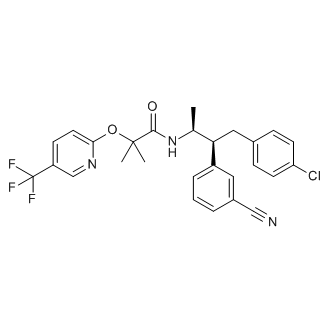| Size | Price | Stock |
|---|---|---|
| 2mg | $119 | In-stock |
| 5mg | $238 | In-stock |
| 10mg | $370 | In-stock |
| 25mg | $766 | In-stock |
| 50 mg | Get quote | |
| 100 mg | Get quote | |
| We match the lowest price on market. | ||
We offer a substantial discount on larger orders, please inquire via [email protected]
or Fax: (86)21-58955996
Inquiry for price and availability only. Please place your order via our email or fax.
| Cat. No. : | HY-10013 |
| M.Wt: | 515.95 |
| Formula: | C27H25ClF3N3O2 |
| Purity: | >98 % |
| Solubility: | DMSO : ≥ 42 mg/mL |
Taranabant is a highly potent and selective cannabinoid 1 (CB1) receptor inverse agonist that inhibits the binding and functional activity of various agonists, with a binding Ki of 0.13 nM for the human CB1R in vitro.
IC50 & Target: IC50: 0.3 nM (hCB1R), 0.4 nM (rCB1R)[1]
Ki: 0.13 nM (hCB1R), 0.27 nM (rCB1R)[1]
In Vitro: Taranabant (MK-0364) binds to human or rat CB1R with an IC50 of 0.3 and 0.4 nM, respectively, corresponding to a Ki value of 0.13 and 0.27 nM, respectively. Taranabant binds to the human or rat CB2R with an IC50 value of 290 and 470 nM, respectively, corresponding to a Ki value of 170 and 310 nM, respectively. The selectivity ratio of CB1R over CB2R is approximately 1000-fold[1]. Taranabant (MK-0364) is a novel, acyclic cannabinoid-1 receptor inverse agonist for the treatment of obesity. IC50s of Taranabant for CB1R and CB2R by substituted amides is 0.3±0.1 nM, and 290±60 nM, respectively. Taranabant is a CB1R inverse agonist with minimal potential for covalent protein binding. Taranabant is an exceptionally potent and selective (900-fold over CB2) CB1R inverse agonist with >500-fold improvement in affinity over the original lead. In a functional assay of cyclic-AMP production, Taranabant is determined to be an inverse agonist (EC50=2.4±1.4 nM)[2].
In Vivo: Taranabant (MK-0364) dose-dependently inhibits 2 h and overnight food intake as well as overnight gains in body weight in C57BL/6N mice. At the 1- and 3-mg/kg doses (p.o.), Taranabant significantly inhibits 2-h food intake (36 and 69% reductions, respectively; P<0.05 and P<0.00001, respectively) and overnight food intake (13 and 40% reductions, respectively; P<0.05 and P<0.00001, respectively) as well as overnight gains in body weight (48 and 165% reductions, respectively; P<0.01 and P<0.00001, respectively). Taranabant dose-dependently inhibits food intake and weight gain, with an acute minimum effective dose of 1 mg/kg in diet-induced obese (DIO) rats[1]. Taranabant (MK-0364) has a good pharmacokinetic profile in three species (rat, 1 mg/kg iv, 2 mg/kg po, F=74%, t1/2=2.7 h; dog, 0.2 mg/kg iv, 0.4 mg/kg po, F=31%; t1/2=14 h; rhesus monkey, 0.2 mg/kg iv, 0.4 mg/kg po, F=31%, t1/2=3.6 h) and good brain exposure (1 mg/kg iv, brain and plasma concentrations of 0.11 and 0.18 μM at 1 h, respectively)[2].
Lorem ipsum dolor sit amet, consectetur adipisicing elit. Autem earum hic iste maiores, nam neque rem suscipit. Adipisci consequatur error exercitationem fugit ipsam optio qui, quibusdam repellendus sed vero! Debitis.
Inquiry Information- Product Name:
- Taranabant
- Cat. No.:
- HY-10013
- Quantity:


Your information is safe with us.